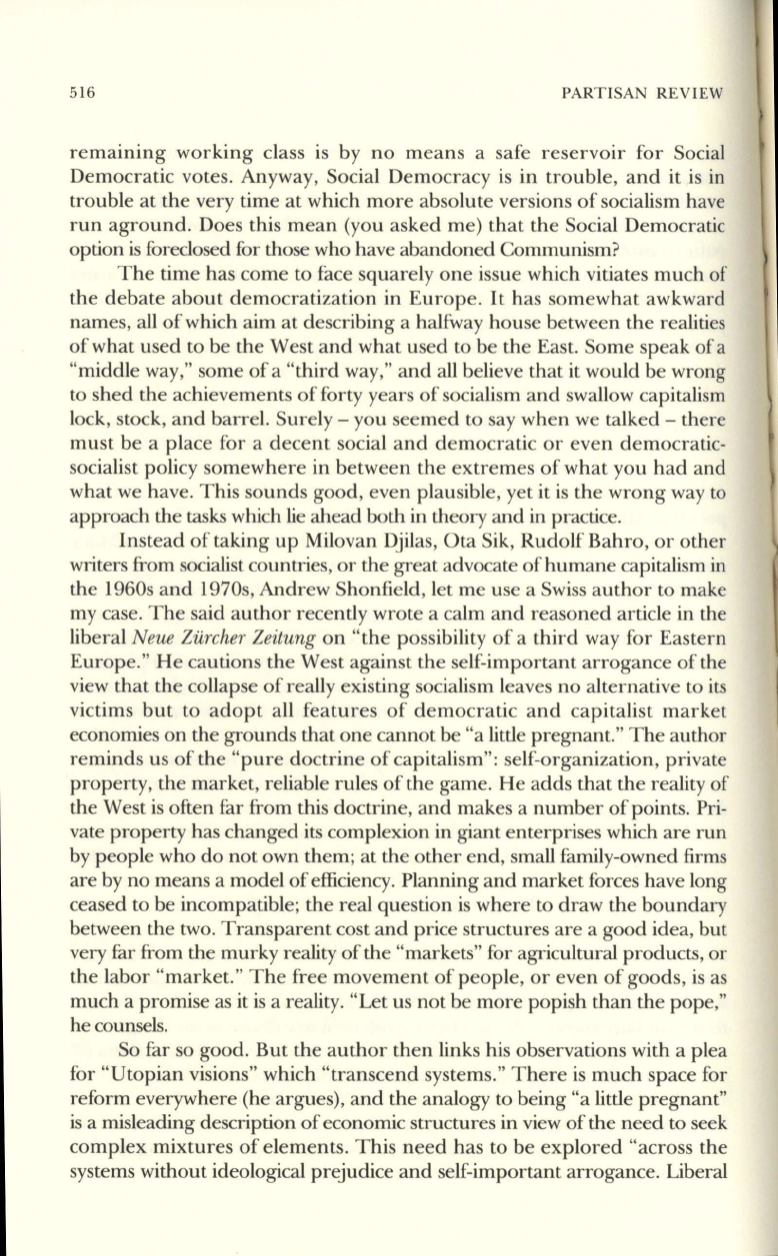
516
PARTISAN REVIEW
remaining working class is by no means a safe reservoir for Social
Democratic votes. Anyway, Social Democracy is in trouble, and it is in
trouble at the very time at which more absolute versions of socialism have
run aground. Does this mean (you asked me) that the Social Democratic
option is foreclosed for those who have abandoned Communism?
The time has come to face squarely one issue which vitiates much of
the debate about democratization in Europe.
It
has somewhat awkward
names, all of which aim at describing a halfway house between the realities
of what used to be the West and what used to be the East. Some speak ofa
"middle way," some ofa "third way," and all believe that it would be wrong
to shed the achievements of forty years of socialism and swallow capitalism
lock, stock, and barrel. Surely - you seemed to say when we talked - there
must be a place for a decent social and democratic or even democratic–
socialist policy somewhere in between the extremes of what you had and
what we have. This sounds good, even plausible, yet it is the wrong way to
approach the tasks which lie ahead both in theory and in practice.
Instead of taking up Milovan Djilas, Ota Sik, Rudolf Bahro, or other
writers from socialist countries, or the great advocate of humane capitalism in
the 1960s and 1970s, Andrew Shonfield, let me use a Swiss author to make
my case. The said author recently wrote a calm and reasoned article in the
liberal
Neue Zurcher Zeitung
on "the possibility of a third way for Eastern
Europe." He cautions the West against the self-important arrogance of the
view that the collapse of really existing socialism leaves no alternative to its
victims but to adopt all features of democratic and capitalist market
economies on the grounds that one cannot be "a little pregnant." The author
reminds us of the "pure doctrine of capitalism": self-organization, private
property, the market, reliable rules of the game. He adds that the reality of
the West is often far from this doctrine, and makes a number of points. Pri–
vate property has changed its complexion in giant enterprises which are run
by people who do not own them; at the other end, small family-owned firms
are by no means a model of efficiency. Planning and market forces have long
ceased to be incompatible; the real question is where to draw the boundary
between the two. Transparent cost and price structures are a good idea, but
very far from the murky reality of the "markets" for agricultural products, or
the labor "market." The free movement of people, or even of goods, is as
much a promise as it is a reality. "Let us not be more popish than the pope,"
he counsels.
So far so good. But the author then links his observations with a plea
for "Utopian visions" which "transcend systems." There is much space for
reform everywhere (he argues), and the analogy to being "a little pregnant"
is a misleading description of economic structures in view of the need to seek
complex mixtures of elements. This need has to be explored "across the
systems without ideological prejudice and self-important arrogance. Liberal


